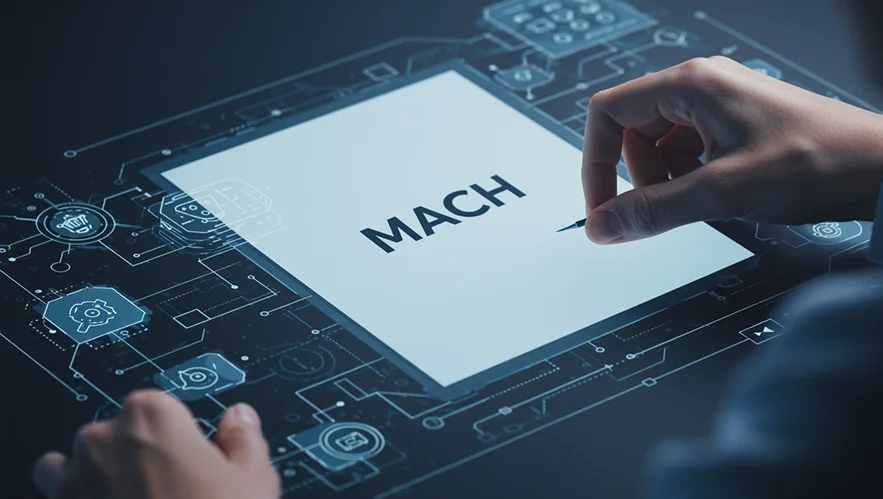Technology is changing fast. Businesses that fail to adapt often find themselves stuck with outdated, slow, and expensive systems that can’t keep up with customer expectations. Websites crash during high traffic, apps take forever to update, and integrating new features feels like a never-ending struggle. Does this sound familiar?
That’s exactly why companies are shifting towards MACH architecture, which is a modern approach that’s flexible, scalable, and built for the future. MACH stands for Microservices, API-first, Cloud-native, and Headless. Unlike traditional monolithic systems that are rigid and difficult to modify, MACH architecture allows businesses to develop digital solutions that grow and evolve effortlessly.
Google, being a leader in cloud computing and digital transformation, offers the perfect ecosystem for MACH-based applications. With Google Cloud’s powerful infrastructure, businesses can build faster, integrate smarter, and scale seamlessly.
But what exactly does MACH architecture mean? And how can businesses use Google’s MACH ecosystem to stay ahead? Let’s break it down in a way that makes sense.
What is MACH Architecture?
MACH essentially means giving businesses the flexibility to create, update, and scale their digital infrastructure without unnecessary complexity. Instead of relying on one giant software system, MACH separates different functions into smaller, independent components that communicate with each other.
Let’s break everything down:
1. Microservices
Microservices are the backbone of MACH architecture. They break down an application into small, independent services, each handling a specific function. Think of them like LEGO bricks you can add, remove, or modify a piece without affecting the entire structure.
For example, in an e-commerce platform, you could have separate microservices for:
- User authentication (logging in, registering, managing accounts)
- Product catalog (storing product details, pricing, and inventory)
- Payments (processing transactions securely)
- Shipping & logistics (handling deliveries, tracking, and order fulfillment)
Since each microservice runs independently, updates or fixes in one service don’t disrupt the entire application. This is a huge advantage over traditional monolithic applications, where a small bug in one section can crash everything.
2. API-First
APIs (Application Programming Interfaces) are bridges that connect different services. An API-first approach ensures that every component in an application communicates efficiently.
For instance, a travel booking app may pull flight data from different airlines, hotel prices from booking platforms, and payment processing from financial service providers—all through APIs. Google’s Apigee API Management helps businesses manage these connections, ensuring security, monitoring, and analytics.
With APIs, businesses can integrate third-party tools and add new features without reworking their entire system. This makes it easier to experiment with new technologies, whether it’s AI-powered recommendations or real-time analytics.
3. Cloud-Native
Instead of relying on traditional, on-premise servers, MACH applications are designed for the cloud from day one. This means businesses can:
- Scale up or down based on demand
- Improve reliability with built-in backups
- Reduce maintenance costs by using managed services
Google Cloud provides a perfect environment for cloud-native applications with tools like:
- Google Kubernetes Engine (GKE) for managing microservices
- Google Cloud Functions for running code without worrying about servers
- Cloud Run for deploying containerized applications effortlessly
Because cloud-native applications aren’t tied to a single server or data center, they offer better performance, security, and cost-efficiency compared to traditional setups.
4. Headless
A headless architecture separates the frontend (what users see) from the backend (where data and logic are stored). This allows businesses to deliver content across multiple channels—websites, mobile apps, smart devices, and even VR/AR experiences—without rebuilding everything from scratch.
For example, an online retailer using Google’s Firebase for backend services can display products seamlessly on a website, mobile app, or voice assistant, all pulling from the same data source.

Why Google’s MACH Architecture?
While MACH is an industry-wide approach, Google’s ecosystem makes it particularly powerful. Here’s why:
1. Scalable Microservices with Google Cloud
Microservices are the backbone of MACH, and Google Cloud makes them easier to manage. Traditional monolithic applications are complex and difficult to scale—one small failure can bring down the entire system. With Google Kubernetes Engine (GKE), businesses can break applications into independent, scalable services that function smoothly, even during high-demand periods.
GKE automates critical operations like:
- Auto-scaling: Whether you have ten users or ten million, GKE dynamically adjusts resources.
- Load balancing: Traffic is efficiently distributed across multiple instances, reducing downtime.
- Security management: Google’s built-in security features protect each microservice, minimizing risks.
For businesses, this means no more crashes during flash sales, seamless feature updates, and a faster go-to-market strategy.
2. Secure and Efficient API Management
APIs are the glue holding MACH-based systems together. Without proper API management, businesses struggle with inconsistent integrations, security vulnerabilities, and sluggish performance. Google’s Apigee API Management Platform solves these challenges by offering:
- Comprehensive API security: Prevent unauthorized access with authentication and encryption.
- Traffic optimization: Apigee monitors API usage and ensures stable performance, even under heavy loads.
- Lifecycle management: From design to deployment, APIs remain organized and scalable.
For companies operating in industries like finance, healthcare, and e-commerce, secure and efficient APIs are crucial for real-time data exchange and smooth customer interactions.
3. Cost-Effective Cloud-Native Solutions
One of the biggest challenges of running digital applications is cost. Maintaining dedicated servers is expensive, and underutilized resources waste money. Google Cloud solves this with Cloud Run and BigQuery.
- Cloud Run: This service allows businesses to run applications only when needed. Resources scale up and down based on demand, ensuring companies don’t pay for unused capacity.
- BigQuery: Processing massive datasets traditionally requires expensive hardware and long processing times. With BigQuery’s serverless architecture, businesses can analyze vast amounts of data instantly—without investing in costly infrastructure.
By adopting these cloud-native technologies, businesses can significantly reduce operational costs while enhancing scalability and efficiency.
4. Headless Content Management & AI-Powered Personalization
Content delivery is evolving. Users now expect personalized experiences across multiple devices—web, mobile apps, smartwatches, and even voice assistants. Google’s MACH ecosystem makes this possible with:
- Firebase for headless content management: Developers can store, retrieve, and manage content independently from the front-end, allowing seamless delivery across platforms.
- Recommendations AI: Google’s machine learning tools analyze user behavior and suggest personalized content, whether it’s products in an online store or recommended articles in a news app.
With Google’s headless and AI-driven capabilities, businesses can offer dynamic, tailored experiences that boost engagement and conversions.

How to Implement Google’s MACH Architecture in Your Business
Adopting MACH architecture isn’t an overnight process. It requires a strategic approach to transition smoothly. Here’s how businesses can implement it effectively:
Step 1: Evaluate Your Current Setup
Before making changes, assess your existing digital infrastructure. Identify:
- Bottlenecks that slow down performance.
- Rigid monolithic components that hinder scalability.
- Cost-heavy operations that can be optimized with cloud solutions.
Step 2: Start with Microservices
Instead of overhauling everything at once, start by breaking down key components into microservices. Examples include:
- User authentication
- Payment processing
- Content management
Step 3: Implement API-First Thinking
APIs should be at the core of your architecture. When building new services, ensure they:
- Are designed with API-first principles to enable easy integration.
- Use Google’s Apigee API Management for security and monitoring.
- Support seamless communication across applications and third-party services.
Step 4: Move to the Cloud
Cloud-native services offer unmatched flexibility and efficiency. Transition away from traditional infrastructure by leveraging:
- Google Cloud Run for on-demand application deployment.
- BigQuery for scalable data analysis without high costs.
- GKE for microservices orchestration.
Step 5: Go Headless for More Flexibility
A headless approach ensures content can be delivered anywhere, anytime. Use:
- Firebase for backend management.
- Headless CMS solutions to separate content from presentation layers.
- Google AI tools for real-time personalization.
Wrapping Up
Google’s MACH architecture offers a powerful way for businesses to build modern, scalable, and flexible digital solutions. By embracing Microservices, API-first development, Cloud-native technologies, and Headless architecture, companies can future-proof their applications, enhance customer experiences, and stay ahead in a rapidly evolving digital landscape.
At BrandCrock, we specialize in MACH-based solutions that help businesses transition smoothly into modern, cloud-native ecosystems. If you’re looking to implement MACH architecture in your business, reach out to us today. We’d love to help you get started.








